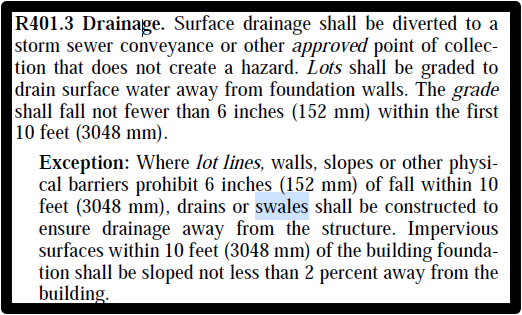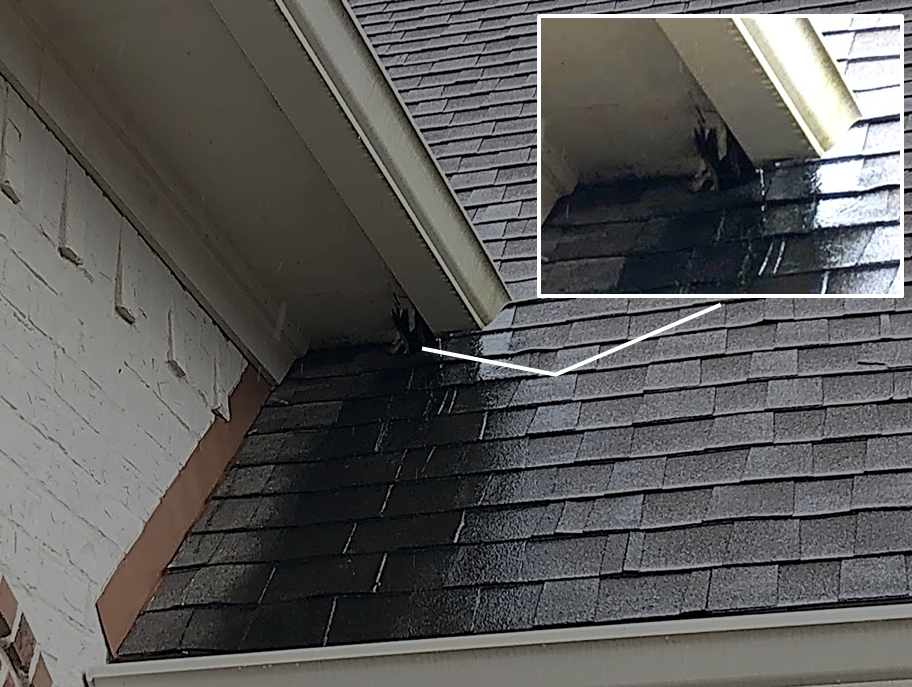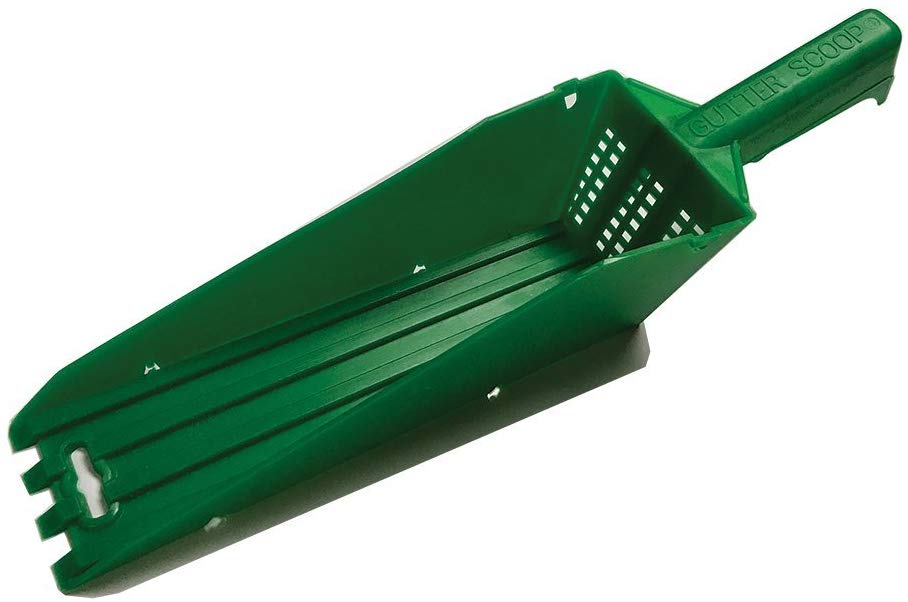Estimated reading time: 9 minutes
Let’s start where most homebuyer’s questions start. Do building codes require gutters? And if they do, what action can I take to address the fact that I don’t have gutters installed on my new home?

No, and it can be a complicated topic. Mississippi doesn’t have a statewide minimum building code requirement – even if there is a local code, how the code official interprets the code can alter the code. See, I told you it’s complicated.
Although there are no hard and fast rules here in Mississippi about gutters, some code officials, the National Association of Home Builders, Energy Star, and the US Green Building Council have something to say about the topic. Here’s a Downloadable PDF.
To minimize soil saturation, houses with foundation walls (crawl spaces and basements) should pay particular attention to how roof water is managed. Most local codes require positive drainage away from the building’s foundation.
One of the country’s oldest building codes, which the FHA still references, is the Council of American Building Officials – CABO. The code dates before the ’70s and ’80s and mentions roof water management.
Final grading shall provide a downward slope away from the house along all foundation walls. The final grade shall provide a minimum slope of one-half unit vertical in 12 units horizontal ( 4 percent slope ) for a minimum of 6 feet from the house.
CABO Code Reference – Section 406.3.5
WHAT DOES THE CODE SAY TODAY
When considering foundation design, the International Code Council (ICC) does not address roof discharge other than to say when you’re finished with the home, the ground should slope away from the foundation.
When designing the foundation, the building official shall determine whether to require a soil test to determine soil bearing capacity. Bearing capacity deals more directly with how the foundation is designed to carry the load of the building. There is no mention of gutters in Chapter 4 of the IRC1 Internation Residential Code . Call your local authority having jurisdiction for specific information.
Chapter 4 states the ground should slope downward away from the building 6 inches in the first 10 feet (5%). The exception to this rule states that when the 10-foot distance cannot be met, there is a lesser slope of 2% for swales. Swales, used in permaculture or landscaping design, slow and capture water runoff by spreading it horizontally across the landscape. This is also known as a ditch.
This slope requirement is also a verifiable standard in EPA’s Indoor airPLUS construction specification for Moisture Control. See 1.1 for Site and Foundation Drainage.

If you don’t have a swale, the slope of the ground away from your foundation should be 5%; if you discharge water from your foundation into a swale, it’s 2%.
In Chapter 8, the code addresses roof drainage. It states that in areas of expansive soils or collapsible soils, ALL dwellings shall have a controlled method of water disposal from roofs that will collect and discharge roof drainage to the ground surface not less than 5 feet from the foundation wall or to an approved drainage system. This detail is also a verifiable standard in EPA’s Indoor airPLUS construction specification for Moisture Control. See 1.7 Gutters, Downspouts and Site Drainage.
The cold truth is that some building officials here in Mississippi don’t “require” that code section be met. Again, call your local authority having jurisdiction for a specific interpretation of the code and more information.
DON’T ALTER THE SLOPE
I’d love to tell you that most new construction finished landscaping in Central Mississippi includes a foundation built with a 5% slope – however, that is not the case. And when the slope is too shallow, water stands for extended periods and causes foundation movement.
Whether the slope is correct or not, homeowners can, and often do, add flower beds, swimming pools, decks, patios, and driveways and make other structural changes to the original build/design. It’s your right as a homeowner. You can make changes to the property. Just know those changes that affect the slope can come with consequences. When you buy a new home and alter the pitch or angle of the soil, you most likely void your builder warranty. Contact an attorney for all legal advice – however, I’ll bet you a cold beer that I’m correct.
I highly suggest you read the warranty. I also suggest you NOT change/alter the drainage within the first 10 feet of your home’s foundation. Whether a code official agrees or has no opinion on the matter, our expansive soils react negatively to ponding water; if not maintained, an improper slope around your home can allow water to seep into the clay and advance foundation problems.
Standing water near foundations WILL have a negative impact on the home’s foundation.
Professional Home Inspector/Construction coach – Gary Smith
Seamless vs. Sectioned Gutters
You’ve decided to maintain roof water discharge with gutters.
Both seamless and sectioned gutters and their downspout materials are made of aluminum, vinyl, galvanized steel, stainless steel, or copper. Most gutters in Central Mississippi are painted aluminum.

Sectional gutters are sold in pieces. They’re usually in 10 to 20 feet “sections” and are cut with a hacksaw.
All sectional systems have end caps, corner pieces, and drop outlets connecting to downspouts. The drawback to sectional systems: all those seams eventually leak.
Seamless gutters won’t leak as much. The lengths are extruded and cut to custom lengths on-site using a portable machine. The most popular sizes are 5 and 6 inches. Seamless gutters also have end caps, corner pieces, and drop outlets for connecting to downspouts.
I prefer and recommend seamless gutter installations. If you use sectioned gutter, watch this video on how to make a splice.
Watch this video and learn how to connect outlets and downspouts.
Regular Inspections and Maintenance Is Important
As mentioned, seamless gutters are the preferred type, and as with anything man-made, quality is most affected by the craftsman’s experience. Hire a professional. I recommend these local pros.
Here are the most critical points to note during regular maintenance and inspections.

- Clean the gutter often. At a minimum, inspect the system twice a year. Beware, tree leaves and small limbs are the culprit.
- Most roof material in Central Mississippi is asphalt shingles. Granule loss is common. Look out for collecting sand and granule material in the base of horizontal gutter runs.
- Seams begin leaking when the silicone caulking/sealer has become brittle and cracked. Look in the base of the gutter and on the inside seams for a damaged seal. Hard freezes can exacerbate failed seals. Ice can weigh the gutter, pull it loose, or/and damage the downspout.
- The #1 reason gutters leak starts with poor slope. Standing water is common. Look for pooling or ponding water in the gutter. Adjust the brackets and fasting devices to adjust the pitch of the channel.
- Check the downspout. It should be securely fastened to the wall and terminated 5 feet from the foundation’s edge. Don’t let the water dump near the foundation.
Once the water is in the gutter system, don’t dump water back onto the roof. Check out my top 4 gutter installation mistakes.
Top 4 Gutter Installation Mistakes

Coming in at #1: Downspout Dumping – dumping water from a higher level gutter to a lower roof line is the worst mistake gutter installers make. Once water is captured in the gutter system, please keep it in the system. It’s common to see fascia and soffit damage from this poor installation mistake. Water will shoot off the end of the gutter and wet the fascia and soffit – where it will wick up into the surrounding wooden surfaces, especially on non-painted ends or the backside. The proper way to move water from an upper to a lower gutter is via a downspout that starts at the top gutter and terminates at the lower gutter.
The second worse mistake is installing a long run of gutter, too flat. Without pitch, water will stand in the gutter. Standing water is a huge No-No. Over time leaves and debris will collect in the gutter flow line. The standing water will stop the gutter and rot the sealant. The extra weight in the gutter will bend the brackets and cause the gutter to sag – making a bad situation worse.

The third mistake – not properly fastening the gutter hangers/brackets. Gutters are fixed to the roof with hangers that must be carefully spaced together to provide a proper lift and support for the gutter. The spacing between the hangers should be installed about three feet or less apart. Improper spacing can lead to sagging gutters (see #2 above). The gutter could eventually pull itself down when loaded in a heavy rain event.
Number 4 – the last of my top mistakes your installer can make is using sectioned gutters. Just don’t do it. Hire a professional and have them install seamless gutters. In the long run, you’ll be glad.
Best Bonus Tip(s):
- When inspecting and cleaning your gutters, it’s best to use a standoff. The ladder attachment will protect your gutter from being scratched and damaged. Werner makes an adjustable product that quickly clips onto most aluminum ladder models.
- When cleaning debris from the gutter channel, use a gutter scoop that allows water to pass through it.
- When the gutter needs to be resealed, use DAP 18377 3.0 Crystal Clear Premium Gutter and Flashing Sealant.
This Article's Footnotes/References
- 1

- - - - - - - - - - - - - - - - - - - - -